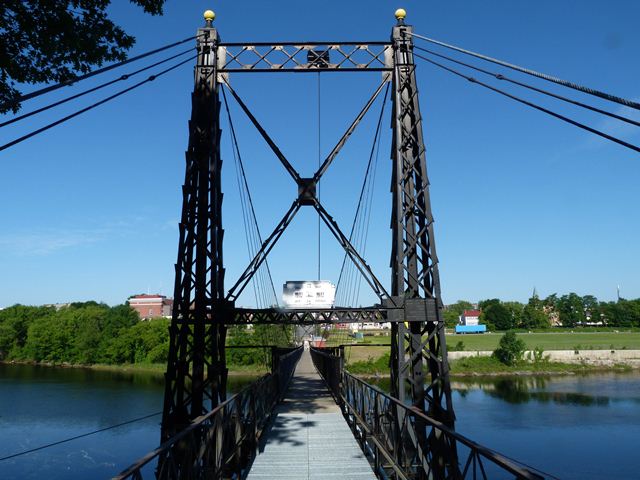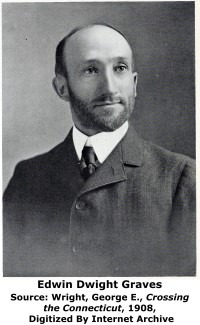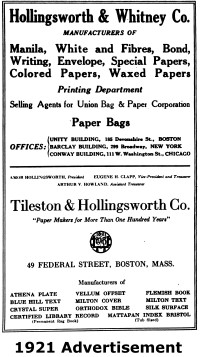We Recommend:
Bach Steel - Experts at historic truss bridge restoration.
BridgeHunter.com Phase 1 is released to the public! - Visit Now
Two Cent Bridge
Ticonic Foot Bridge

Primary Photographer(s): Nathan Holth
Bridge Documented: June 17, 2012
Waterville: Kennebec County, Maine: United States
Metal Pony Truss Stiffening Wire Cable Suspension, Fixed and Approach Spans: Metal Rivet-Connected Warren Pony Truss, Fixed
1903 By Builder/Contractor: Berlin Construction Company of Berlin Connecticut and Engineer/Design: Edwin Dwight Graves of Hartford, Connecticut
2012
400.0 Feet (121.9 Meters)
Not Available
6 Feet (1.83 Meters)
1 Main Span(s) and 2 Approach Span(s)
Not Applicable

View Information About HSR Ratings
Bridge Documentation
View Two Historical Biographies of Engineer Edwin Dwight Graves
This bridge is a very large example of a suspension foot bridge. Suspension foot bridges were built throughout the United States as a solution for situations where pedestrians needed to access a location, but vehicular access was not needed. Due to their design, suspension foot bridges tend to move quite noticeably under live load (people walking on the bridge) which has led to these bridges often being called "swinging bridges".
This bridge is composed of an impressive 400 foot main span. The eastern end has a steel stringer approach span and the western end has a pony truss approach span.
This bridge was built to provide workers in Waterville with access to a Hollingsworth and Whitney Company factory. The company was a paper producer.
The Two Cent Bridge's name comes from the toll that was originally charged to use the bridge by the owner of the bridge, the Taconic Bridge Company. Tolls ended at the bridge in 1960 when the bridge was given to the city of Waterville. The shell of a toll building, either a restored or reconstructed structure, remains in place at the western end of the bridge.
This bridge was a replacement for a short-lived bridge built in 1901 that was destroyed in a flood. The 1901 bridge had a one cent toll, and when it was replaced in 1903, the toll became two cents.
In 2012, the bridge was rehabilitated for continued pedestrian use. This effort is positive and represents a commitment to the preservation of this important historic bridge. The metal grate deck of the bridge was replaced. Also, the horizontal wind cables that provide bracing for the bridge against wind were replaced.
Also as part of this 2012 project, the original lattice railing on the bridge was removed and replaced with a modern railing. The replacement railing in general is a good choice for the bridge, since it looks dignified, has a metal design that compliments the fact that the bridge is a metal bridge, and also the railing does not block the view of the stiffening truss and other structural details of the bridge. However, it is most unfortunate that the original lattice railings were removed. It would have been nice to see these original railings left in place behind the new railings. Alternatively, perhaps some creative engineering could have retrofitted the existing original railing to meet current safety requirements. One of the unusual, and unexplained aspects of surviving pedestrian suspension foot bridges is that most suffer from a loss of large amounts of original bridge material. While the removal of the railing is not a major loss of integrity, and the Two Cent Bridge still retains higher than average historic integrity, this is a loss nonetheless. This railing replacement was on-going and nearly complete when HistoricBridges.org documented the bridge. However, a few segments of the original railing remained (most notably on the pony truss span) and were photographed by HistoricBridges.org.
Also as part of the 2012 rehabilitation project the pony truss was apparently raised up.
![]()
Photo Galleries and Videos: Two Cent Bridge
Bridge Photo-Documentation
Original / Full Size PhotosA collection of overview and detail photos. This gallery offers photos in the highest available resolution and file size in a touch-friendly popup viewer.
Alternatively, Browse Without Using Viewer
![]()
Bridge Photo-Documentation
Mobile Optimized PhotosA collection of overview and detail photos. This gallery features data-friendly, fast-loading photos in a touch-friendly popup viewer.
Alternatively, Browse Without Using Viewer
![]()
Maps and Links: Two Cent Bridge
Coordinates (Latitude, Longitude):
Search For Additional Bridge Listings:
Bridgehunter.com: View listed bridges within 0.5 miles (0.8 kilometers) of this bridge.
Bridgehunter.com: View listed bridges within 10 miles (16 kilometers) of this bridge.
Additional Maps:
Google Streetview (If Available)
GeoHack (Additional Links and Coordinates)
Apple Maps (Via DuckDuckGo Search)
Apple Maps (Apple devices only)
Android: Open Location In Your Map or GPS App
Flickr Gallery (Find Nearby Photos)
Wikimedia Commons (Find Nearby Photos)
Directions Via Sygic For Android
Directions Via Sygic For iOS and Android Dolphin Browser
USGS National Map (United States Only)
Historical USGS Topo Maps (United States Only)
Historic Aerials (United States Only)
CalTopo Maps (United States Only)





